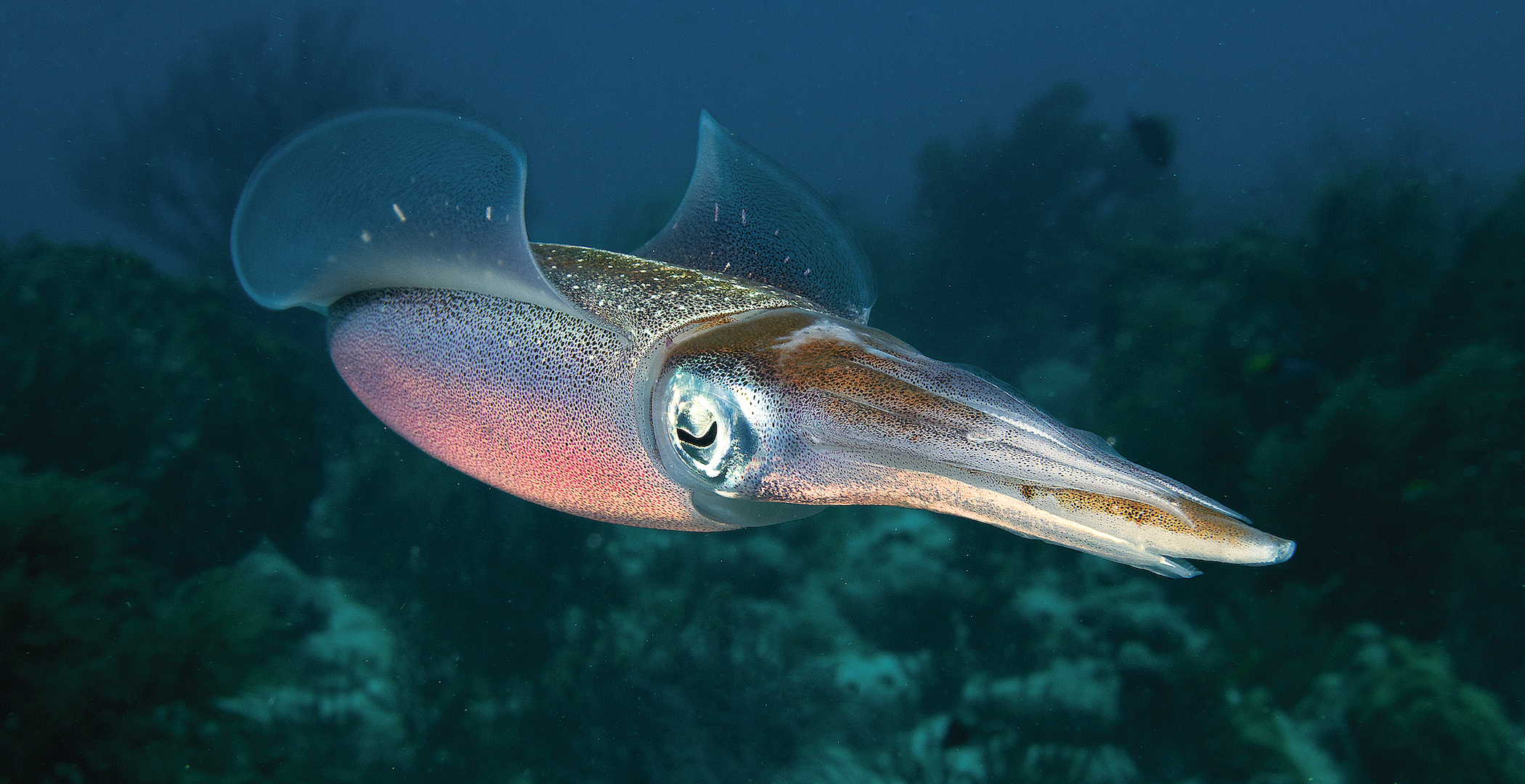Cephalopods: Facts about octopus, squid, nautilus and more
Cephalopods are often characterized by their tentacles, creative camouflage, inky getaways and impressive feats of intelligence.

Cephalopods are members of a class of marine animals that includes octopuses, squid, cuttlefish and nautiluses. The group includes more than 800 species (and new species are still being found), according to CephBase on the Encyclopedia of Life, a database that's part of the Smithsonian Institution's National Museum of Natural History. Many cephalopods have tentacles, possess color-changing abilities, can spray ink and exhibit impressive feats of intelligence — though not all cephalopods have all these traits.
The word cephalopod means "head foot" in Greek, referring to the fact that these two body parts are merged in these animals, according to the New World Encyclopedia. There is a wide variety of body types among the group, but the basic body plan for a cephalopod includes a minimum of eight arms, a siphon, a mantle and two eyes. Nautiluses have shells, other cephalopods have soft bodies covered in a tough skin. Despite having the most complex neurology of all invertebrates, most cephalopods only live for months or one to two years, depending on the species, though some nautilus can live for more than 20 years. All species of cephalopods live in saltwater environments, and while some species can tolerate brackish, or slightly salty water, none can live in freshwater.
Octopuses and squid are the most well-known members of the Cephalopoda class of animals. They all evolved from a common, hard-shelled ancestor (more similar to a nautilus). Parts of their evolution can be trickier to track than other mollusks, due to the fact that these are soft-bodied animals that don't fossilize well.
Related: 8 Crazy facts about octopuses
Where do cephalopods live?
Except for nautilus (all six species live only in the Indo-Pacific Ocean between Asia and Australia), cephalopods live throughout Earth's oceans, according to Chicago's Field Museum, including in shallow-water nearshore ecosystems, in open ocean areas near the surface, in the dark of the mid-ocean, and as deep as 26,000 feet (7,900 meters) below the water's surface.
Cuttlefish typically spend winters in deeper waters, then move to shallow, often coastal waters to breed in the spring and summer. Generally, octopuses tend to spend time on the seafloor and are solitary, only getting together to mate. Squid tend to be more social, spending time in groups that protect them from predators. But as with most groups of animals, there are exceptions.
Related: Octlantis: See photos of tight-knit gloomy octopus communities
Get the world’s most fascinating discoveries delivered straight to your inbox.
"There are solitary squids in the deep sea," said Janet Voight, Women's Board Associate Curator of Invertebrate Zoology at the Field Museum in Chicago. "In shallow waters they form groups to protect themselves from visual predators, and the deep ocean means they don't have to," she said.
Similarly, although most octopus species are solitary, at least one species, the larger Pacific striped octopus (which hasn't been formally described) form mated pairs and live in groups, and researchers have recently discovered large groups of common Sydney octopuses (Octopus tetricus) living together, Live Science previously reported.
What do cephalopods eat?
Octopuses eat everything from starfish to clams, snails, small fish and even other octopuses. "Octopuses and squids live by killing and eating other animals, but because they have that permeable skin and they're really good protein, they're preyed on by almost everything else that's got teeth," Voight said.
Squid and cuttlefish eat mostly fish and crustaceans and nautilus are mostly scavengers, finding discarded pieces of other animals' prey on the seafloor, though they also hunt fish, crabs and shrimp.
Related: Giant squid: The real-life ocean Kraken
Cephalopods are central to the health of the entire ocean ecosystem. Because they are both predator and prey, "they're really central to connecting different levels of the food web," said Danna Staaf, a marine biologist and author of "Monarchs of the Sea: The Extraordinary 500-Million-Year History of Cephalopods" (The Experiment, 2020).
How do cephalopods move?
All cephalopods move by filling their body cavity with water and squirting it out through a siphon, which creates a narrow jet of water that propels the animal in the opposite direction, Staaf explained. Depending on their muscle and body structure, some cephalopods are faster or more mobile than others. For example, the long, narrow body shape of squid enables them to move faster than many octopus species. Octopuses, on the other hand, have muscular tentacles that enable them to walk or crawl across the ocean floor in addition to jetting around the water column.
Nautiluses, which have up to 90 tentacles, are protected by their hard shells, so movement isn't as critical for evading predators. But squid and octopuses don't have shells, which means they need some other way of escaping predators. "For squid, that's mostly swimming very fast, although they do have some camouflage," Staaf said. "And for octopuses, it's usually a combination of camouflage and hiding in these very tiny spaces that other predators can't fit into."
While the hard shell of their ancestors has completely disappeared in octopuses, giving them amazing flexibility, the shell evolved into an internal support rod in squid, which "holds their body long and straight and is something for their muscles to work against," Staaf said. "It makes them very hydrodynamic — so, very fast swimmers."
Some squids can even fly, according to a 2020 study published in the journal Bioinspiration & Biomimetics. If the squid are pointed toward the surface, the jet of water can propel them into the air. "They can actually keep the jet going while they're in the air to continue to propel themselves forward," Staaf said. And the small fins on either side of their body act like wings to carry them through the air for a short distance. Why squid occasionally fly through the air is unknown, but some experts suspect it's to escape predators. Another theory is that jumping through the air may actually be more efficient for traveling long distances, according to Staaf.
Squid species known as glass squids, belonging to the Crandiidae family, have another locomotion advantage. These squids can use their waste ammonia (which comes from digesting meat and is stored in a special body cavity) to give them a free lift, since ammonia weighs less than salt water. "Although [ammonia is] a toxic chemical, they can somehow sequester it in their bodies," Voight said. This buoyancy means less work for the squid — they can just float.
Cephalopod camouflage
Many cephalopods, including octopuses, squid and cuttlefish have evolved impressive camouflage abilities, able to change the color and iridescence of their skin, flash them rapidly, and even create patterns to mimic the environment around them. They do this to both hide from predators and disguise themselves from prey. They also use their color changing abilities as a means of communication, Live Science previously reported. "The reef squid has been most studied for the communication that happens between members of the species that borders on a language," Staaf said.
Changing colors isn't the only way to hide: Glass squids are transparent, which can be a huge advantage in the ocean, because it makes the animals more difficult to see, thus protecting them from predators, according to a 2011 report published in the journal Current Biology.
Adding to their evasive techniques, many types of squids, octopuses and cuttlefish are able to use a self-produced ink to cloud the water and potentially confuse or irritate their predators.
How do cephalopods reproduce?
After a female octopus mates with a male and lays her fertilized eggs (in a den, on the seafloor, or on a rock face), she stops eating and stays with the eggs, aerating them and protecting them until they hatch, Staaf said. "Then the octopus mother dies about when the eggs are hatching," she said. In 2007, the deep sea octopus Graneledone boreopacifica surprised scientists when she stayed with her eggs for over four years, brooding longer than any known animal.
While it was long assumed that all cuttlefish and squids lay their eggs and then perish, there's at least one species of squid that doesn't. In 2005, scientists witnessed a specific type of deep-sea squid (Gonatus onyx) carrying a large mass of eggs around in her arms. The squid bubbled air through the eggs so they had enough oxygen, and kept them safe from predators until they hatched. "Before 2005, nobody knew that any squid ever did that," Staaf said, which shows how much more there is to learn about cephalopods, she added.
Once hatched, most cephalopods are tiny but grow quickly, doubling in size within two or three weeks, Voight said. "They go from being afraid of almost everything, to being able to kill and eat things that were killing and eating their siblings the week before," she said.
Additional resources
- Learn more about cephalopod taxonomy from the Tree of Life.
- Find more fun facts about cephalopods from the University of California, Berkeley.
- Learn about the types of cephalopods that are kept in aquariums from the University of Chicago's Marine Biological Laboratory.

Starre Vartan writes about science, nature, and the female body — especially the parts that are strong, misunderstood, or totally ignored. Her work’s been published in National Geographic, Scientific American, Undark, Aeon, and New Scientist, among other outlets. Her latest book, "The Stronger Sex: What Science Tells Us about the Power of the Female Body," was published in July 2025. She started her career as a geologist and later earned an MFA in nonfiction from Columbia University.



